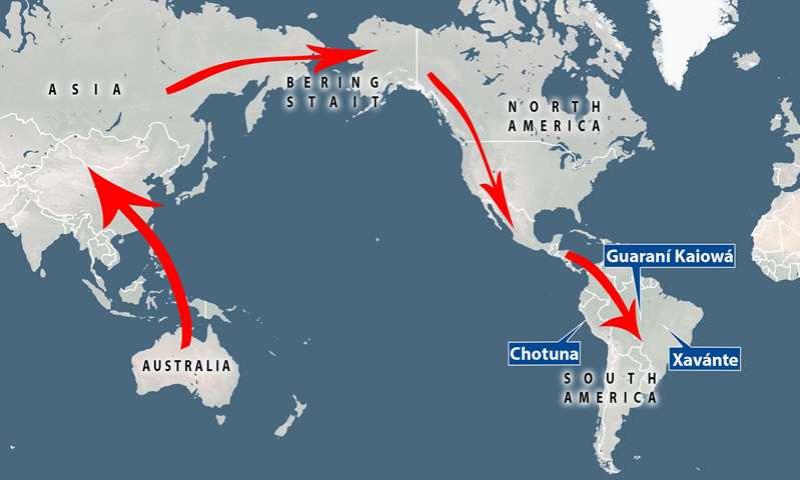Indigenous South American tribes found to have ancient Australian DNA


Australia is deemed the most isolated continent on Earth, but DNA from early indigenous groups spread throughout the world and specifically into the ancient bloodline of South American tribes.
Previous work from 2015 first uncovered a link between ancient Australians and Amazonian groups, but a new study finds it runs even deeper that previously believed.
A genomic analysis of individuals from a number of indigenous South American groups uncovered hallmarks of Australasian influence in Peru and Brazil, and showed it was first introduced through the Pacific coastal route before the formation of the Amazonian branch.
Although the findings may spark a wonderous story of ancient Australians crossing the Pacific Ocean in boats to South America, the new genetic model shows no evidence of an expedition - but instead, they walked.
Researchers propose the ancestry stems from early Australians who integrated with the first Americans who made the long journey from Asia over the Bering Strait Land Bridge some 15,000 years ago.
The genetic analysis also showed these individuals may have clung to the Pacific coast while traveling through North America, which may explain why natives in the US do not have the genetic markers.
The Bering Strait Land Bridge, also known as Beringia, formed toward the end of the Ice Age when sea levels began to drop and slowly exposed flat, grassy land hiding beneath.
The land connected Asia to North America, stretching one thousands miles from north to south, and became a vital path of transportation between Asia and North America.
The new study proposes this now gone landmass is what led to South Americans having Australian DNA.
The team built this study on previous researcher that discovered the Australasian population genetic component 'Ypikuéra population' or 'Y population' exclusively among present-day Amazonian populations.
Researchers collected genomic data from 383 individuals, resulting in 438,443 markers, from different South American indigenous tribes.
Following the analysis, the team found the Y signal not only exists in Amazonian groups, but also in the indigenous peoples of Chotuna (living near the Pacific coast of Peru), Guaraní Kaiowá (central west Brazil), and Xavánte (close to the center of Brazil).
'Our results showed that the Australasian genetic signal, previously described as exclusive to Amazonian groups, was also identified in the Pacific coastal population, pointing to a more widespread signal distribution within South America, and possibly implicating an ancient contact between Pacific and Amazonian dwellers,' the researchers, led by first author and evolutionary biologist Marcos Araújo Castro e Silva from the University of São Paulo (USP) in Brazil, explain in their study published in PNAS .
The findings also revealed there was at least two migratory waves in South America of ancient people with Australasian genetic DNA.
The first wave settled in the Pacific coastal regions and the one that followed moved eastwards to the Amazon and central Brazil.
The study also acknowledges why Australasian genetic DNA has not been found in the bloodline of Native Americans.
'This genetic evidence for the presence of Y ancestry on the South American Pacific coast indicates that this ancestry likely reached this region through the Pacific coastal route, and therefore could explain absence of this genetic component in the populations of North and Central America studied so far,' the study states.
Tags
Who is online
52 visitors

While I still like the idea of a sailing route direct to SA this does explain the genetics of the area nicely
Since there were, and are, native populations along the Pacific coast of North and Central America, it is not at all clear what the study claims explains the absence of the genetic component in those populations.
Also, it seems more likely that the Australian indigenous population and the American indigenous population have the same source, as opposed to the American indigenous population being directly descendent from the Australian indigenous population.
At one point in time, the Americans and Australia were connected by land.
Native American DNA was found in 11% of the people of Easter Island and this was traced in time long before Europeans were in the Pacific. The trade between the peoples of Easter Island and mainland So. America included sweet potato and those come from SA and they were found growing on Easter Island.
The Mud Lake Man in Australia has been dated to 50,000 years ago. much older than any confirmed in North or South America.
It's fun but so many questions are unanswered. The latest is that North American Indians have identical markers in their DNA to a people from NE Siberia that no one knew existed until a few years ago.
Didn't we have a really good discussion on NV about the boats that the Polynesians and Aborigines used to travel the Pacific and how there were artifacts from China, Borneo and Australia on the coast of Peru and Chile? Also goes in line with "1492" and some of the remnants listed.
Glad to see that there's more food for the dish.
Yes, we did, and there was a lot of good discussion and ideas in those discussions.
That is certainly interesting, but the article indicates it was 1 billion years ago. Wouldn't that be before the existence of the human species?
With regard to Easter Island, I think one of the most telling points is that the word for sweet potato in Polynesian languages is "kumara" , "kumala" and "umala" and the word for sweet potato in Quechua, an indigenous language of Northwest South America, is "cumal" and "cumar".
Yes, it was one billion years ago but again are we sure that landbridge disappeared completely? It's possible that it because a series of islands for some time. Then again it could mean very little.
Yes, the words are quite similar that along with the DNA makes for very interesting discussions. Can you sail from the coast of SA to Easter Island? Yes, you can and Thor Heyerdahl and the Kon Tiki proved that SA natives could have sailed to Easter Island and vis versa.
We don't know when the possible land bridge between Australia and America, or series of islands, might have disappeared, of course.
I don't think there is too much doubt that there was likely some contact between the Polynesian people of Easter Island and SA natives.
If they have Australian blood, I guess they are not indigenous to SA then.
Always interesting.
Could this explain my recent uncontrollable urge to try to play a digeridoo?